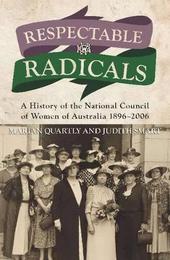
|
Respectable Radicals: A history of the National Council of Women in Australia, 1896 - 2006
Paperback / softback
Main Details
| Title |
Respectable Radicals: A history of the National Council of Women in Australia, 1896 - 2006
|
| Authors and Contributors |
By (author) Marion Quartly
|
|
By (author) Judith Smart
|
| Physical Properties |
| Format:Paperback / softback | | Pages:200 | | Dimensions(mm): Height 234,Width 153 |
|
| Category/Genre | Australia, New Zealand & Pacific history |
|---|
| ISBN/Barcode |
9781922235947
|
| Classifications | Dewey:323.340994 |
|---|
| Audience | |
|---|
| Illustrations |
30 b&w illus
|
|
Publishing Details |
| Publisher |
Monash University Publishing
|
| Imprint |
Monash University Publishing
|
| Publication Date |
1 November 2015 |
| Publication Country |
Australia
|
Description
For much of the twentieth century, the National Council of Women of Australia was the peak body representing women to government in Australia, and through the International Council of Women, to the world. This history of NCWA tells the story of mainstream feminism in Australia, of the long struggle for equality at home and at work which is still far from achieved. In these days when women can no longer be imagined as speaking with one voice, and women as a group have no ready access to government, we still need something of the optimistic vision of the leaders of NCWA. Respectable in hat and gloves to the 1970s and beyond, they politely persisted with the truly radical idea that women the world over should be equal with men.
Author Biography
Marian Quartly has taught and researched Australian history at Monash University for longer than she cares to remember. Her publications include the co-authored Creating a Nation, a feminist history of Australia. She is currently writing about gendered citizenship (male and female), about museums and virtual communities, and about the history of adoption in Australia. Her interest in visual representations of gendered citizens in this case of workers and capitalists arises out of the need to relate to a visually oriented generation of students.
|